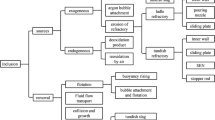Abstract
During continuous casting of aluminum-killed steels, the pouring rate through the tundish nozzle often diminishes, posing serious operating problems. This happens because a buildup of microscopic alumina particles at the nozzle orifice effectively decreases the nozzle orifice diameter and causes constriction of the liquid-steel pouring stream. There are two major aspects of the constriction problem: (1) the source of the depositing particles, and (2) the mechanism by which the particles deposit at the nozzle orifice. Detailed microscopic examination of the buildup of alumina particles in nozzles from various casting trials and petrographic examination of the nozzle refractory indicated that the particles depositing at the nozzle orifice were already present in the melt because of deoxidation and reoxidation processes. A model proposed herein explains why and how the alumina particles deposit and stay at the nozzle orifice. The model considers a microscopically thin boundary layer at the nozzle bore where the velocity of the liquid steel approaches zero. Particles passing close to the refractory surface and in the slow-moving boundary layer attach to the wall and to each other. The presence of eddy currents in and close to the turbulent boundary layer increase the particle to particle collision. Such collisions of the particles thrown from outer region of boundary layers with the already attached particles keep on dumping the particles toward the refractory surface. The high interfacial energy of alumina inclusions in steel is a driving force for particles to attach to the refractory wall and to each other, and high-température sintering then occurs to form a network of alumina particles.
Similar content being viewed by others
References
R. B. Snowand J. A. Shea: J. Amer. Cer. Soc, 1949, vol. 32, no. 6, pp. 187–94.
G. C. Duderstadt, R. K. Iyengar, and J. M. Matesa: J. Metals, 1968, vol. 20, no. 4, pp. 89–94.
A. K. Karklite, et al: Ogneupomy, 1970, vol. 35, no. 7, pp. 27–35, H.B. 8363.
N. M. Frolovskii, et al.: Ogneupomy, 1970, vol. 35, no. 8, pp. 22–27, H.B. 8295.
V. P. Schevchenko, et al: Ogneupomy, 1970, vol. 35, no. 10, pp. 31–33, H.B. 8345.
K. Schweidtfetger and H. Schteve: AIME Electric-Furnace Conference Pro- ceedings, 1970, p. 95.
D. C. Hilty and J. W. Farrell: AIME Electric Furnace Proceedings, 1971, pp. 31- 46.
R. L. Coble: J. Amer. Cer. Soc, 1958, vol. 41, no. 2, p. 55.
Author information
Authors and Affiliations
Rights and permissions
About this article
Cite this article
Singh, S.N. Mechanism of alumina buildup in tundish nozzles during continuous casting of aluminum-killed steels. Metall Trans 5, 2165–2178 (1974). https://doi.org/10.1007/BF02643930
Received:
Published:
Issue Date:
DOI: https://doi.org/10.1007/BF02643930




